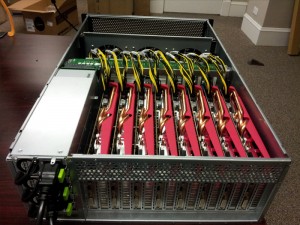ditor’s note: I’ve updated the article with some new (and in some cases) clarifying detail from Jeremi. I’ve left changes in where they were made. The biggest changes: 1) an updated link to slides 2) clarifying that VCL refers to Virtual OpenCL and 3) that the quote regarding 14char passwords falling in 6 minutes was for LM encrypted – not NTLM encrypted passwords. Long (8 char) NTLM passwords would take much longer…around 5.5 hours.
There needs to be some kind of Moore’s law analog to capture the tremendous advances in the speed of password cracking operations. Just within the last five years, there’s been an explosion in innovation in this ancient art, as researchers have realized that they can harness specialized silicon and cloud based computing pools to quickly and efficiently break passwords.

Gosney’s system elevates password cracking to the next level, and effectively renders even the strongest passwords protected with weaker encryption algorithms, like Microsoft’s LM and NTLM, obsolete.
In a test, the researcher’s system was able to churn through 348 billion NTLM password hashes per second. That renders even the most secure password vulnerable to compute-intensive brute force and wordlist (or dictionary) attacks. A 14 character Windows XP password hashed using LM NTLM (NT Lan Manager), for example, would fall in just six minutes, said Per Thorsheim, organizer of the Passwords^12 Conference.
[Note of clarification from Jeremi: "LM Is what is used on Win XP, and LM converts all lowercase chars to uppercase, is at most 14 chars long, and splits the password into two 7 char strings before hashing -- so we only have to crack 69^7 combinations at most for LM. At 20 G/s we can get through that in about 6 minutes. With 348 billion NTLM per second, this means we could rip through any 8 character password (95^8 combinations) in 5.5 hours." ]
“Passwords on Windows XP? Not good enough anymore,” Thorsheim said.
Tools like Gosney’s GPU cluster aren’t suited for an “online” attack scenario against a live system. Rather, they’re used in “offline” attacks against collections of leaked or stolen passwords that were stored in encrypted form, Thorsheim said. In that situation, attackers aren’t limited to a set number of password attempts – hardwareand software limitations are all that matter.
The clustered GPUs clocked impressive speeds against more sturdy hashing algorithms as well, including MD5 (180 billion attempts per second, 63 billion/second for SHA1 and 20 billion/second for passwords hashed using the LM algorithm. So called “slow hash” algorithms fared better. The bcrypt (05) and sha512crypt permitted 71,000 and 364,000 per second, respectively.








